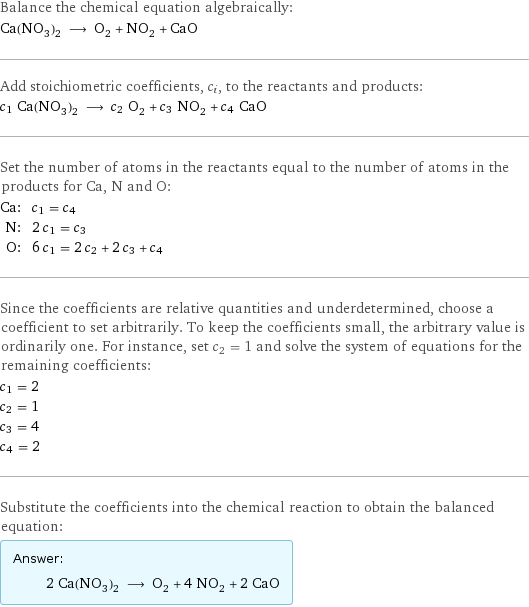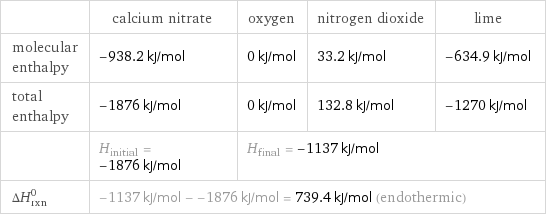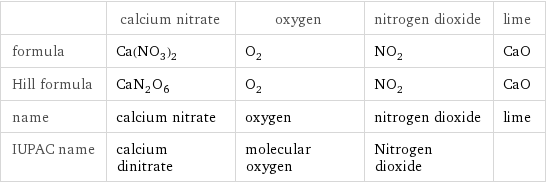Input interpretation

Ca(NO_3)_2 calcium nitrate ⟶ O_2 oxygen + NO_2 nitrogen dioxide + CaO lime
Balanced equation

Balance the chemical equation algebraically: Ca(NO_3)_2 ⟶ O_2 + NO_2 + CaO Add stoichiometric coefficients, c_i, to the reactants and products: c_1 Ca(NO_3)_2 ⟶ c_2 O_2 + c_3 NO_2 + c_4 CaO Set the number of atoms in the reactants equal to the number of atoms in the products for Ca, N and O: Ca: | c_1 = c_4 N: | 2 c_1 = c_3 O: | 6 c_1 = 2 c_2 + 2 c_3 + c_4 Since the coefficients are relative quantities and underdetermined, choose a coefficient to set arbitrarily. To keep the coefficients small, the arbitrary value is ordinarily one. For instance, set c_2 = 1 and solve the system of equations for the remaining coefficients: c_1 = 2 c_2 = 1 c_3 = 4 c_4 = 2 Substitute the coefficients into the chemical reaction to obtain the balanced equation: Answer: | | 2 Ca(NO_3)_2 ⟶ O_2 + 4 NO_2 + 2 CaO
Structures

⟶ + +
Names

calcium nitrate ⟶ oxygen + nitrogen dioxide + lime
Reaction thermodynamics
Enthalpy

| calcium nitrate | oxygen | nitrogen dioxide | lime molecular enthalpy | -938.2 kJ/mol | 0 kJ/mol | 33.2 kJ/mol | -634.9 kJ/mol total enthalpy | -1876 kJ/mol | 0 kJ/mol | 132.8 kJ/mol | -1270 kJ/mol | H_initial = -1876 kJ/mol | H_final = -1137 kJ/mol | | ΔH_rxn^0 | -1137 kJ/mol - -1876 kJ/mol = 739.4 kJ/mol (endothermic) | | |
Gibbs free energy

| calcium nitrate | oxygen | nitrogen dioxide | lime molecular free energy | -742.8 kJ/mol | 231.7 kJ/mol | 51.3 kJ/mol | -603.3 kJ/mol total free energy | -1486 kJ/mol | 231.7 kJ/mol | 205.2 kJ/mol | -1207 kJ/mol | G_initial = -1486 kJ/mol | G_final = -769.7 kJ/mol | | ΔG_rxn^0 | -769.7 kJ/mol - -1486 kJ/mol = 715.9 kJ/mol (endergonic) | | |
Equilibrium constant
![Construct the equilibrium constant, K, expression for: Ca(NO_3)_2 ⟶ O_2 + NO_2 + CaO Plan: • Balance the chemical equation. • Determine the stoichiometric numbers. • Assemble the activity expression for each chemical species. • Use the activity expressions to build the equilibrium constant expression. Write the balanced chemical equation: 2 Ca(NO_3)_2 ⟶ O_2 + 4 NO_2 + 2 CaO Assign stoichiometric numbers, ν_i, using the stoichiometric coefficients, c_i, from the balanced chemical equation in the following manner: ν_i = -c_i for reactants and ν_i = c_i for products: chemical species | c_i | ν_i Ca(NO_3)_2 | 2 | -2 O_2 | 1 | 1 NO_2 | 4 | 4 CaO | 2 | 2 Assemble the activity expressions accounting for the state of matter and ν_i: chemical species | c_i | ν_i | activity expression Ca(NO_3)_2 | 2 | -2 | ([Ca(NO3)2])^(-2) O_2 | 1 | 1 | [O2] NO_2 | 4 | 4 | ([NO2])^4 CaO | 2 | 2 | ([CaO])^2 The equilibrium constant symbol in the concentration basis is: K_c Mulitply the activity expressions to arrive at the K_c expression: Answer: | | K_c = ([Ca(NO3)2])^(-2) [O2] ([NO2])^4 ([CaO])^2 = ([O2] ([NO2])^4 ([CaO])^2)/([Ca(NO3)2])^2](../image_source/8166f8c41f552286afcd15a7643cac21.png)
Construct the equilibrium constant, K, expression for: Ca(NO_3)_2 ⟶ O_2 + NO_2 + CaO Plan: • Balance the chemical equation. • Determine the stoichiometric numbers. • Assemble the activity expression for each chemical species. • Use the activity expressions to build the equilibrium constant expression. Write the balanced chemical equation: 2 Ca(NO_3)_2 ⟶ O_2 + 4 NO_2 + 2 CaO Assign stoichiometric numbers, ν_i, using the stoichiometric coefficients, c_i, from the balanced chemical equation in the following manner: ν_i = -c_i for reactants and ν_i = c_i for products: chemical species | c_i | ν_i Ca(NO_3)_2 | 2 | -2 O_2 | 1 | 1 NO_2 | 4 | 4 CaO | 2 | 2 Assemble the activity expressions accounting for the state of matter and ν_i: chemical species | c_i | ν_i | activity expression Ca(NO_3)_2 | 2 | -2 | ([Ca(NO3)2])^(-2) O_2 | 1 | 1 | [O2] NO_2 | 4 | 4 | ([NO2])^4 CaO | 2 | 2 | ([CaO])^2 The equilibrium constant symbol in the concentration basis is: K_c Mulitply the activity expressions to arrive at the K_c expression: Answer: | | K_c = ([Ca(NO3)2])^(-2) [O2] ([NO2])^4 ([CaO])^2 = ([O2] ([NO2])^4 ([CaO])^2)/([Ca(NO3)2])^2
Rate of reaction
![Construct the rate of reaction expression for: Ca(NO_3)_2 ⟶ O_2 + NO_2 + CaO Plan: • Balance the chemical equation. • Determine the stoichiometric numbers. • Assemble the rate term for each chemical species. • Write the rate of reaction expression. Write the balanced chemical equation: 2 Ca(NO_3)_2 ⟶ O_2 + 4 NO_2 + 2 CaO Assign stoichiometric numbers, ν_i, using the stoichiometric coefficients, c_i, from the balanced chemical equation in the following manner: ν_i = -c_i for reactants and ν_i = c_i for products: chemical species | c_i | ν_i Ca(NO_3)_2 | 2 | -2 O_2 | 1 | 1 NO_2 | 4 | 4 CaO | 2 | 2 The rate term for each chemical species, B_i, is 1/ν_i(Δ[B_i])/(Δt) where [B_i] is the amount concentration and t is time: chemical species | c_i | ν_i | rate term Ca(NO_3)_2 | 2 | -2 | -1/2 (Δ[Ca(NO3)2])/(Δt) O_2 | 1 | 1 | (Δ[O2])/(Δt) NO_2 | 4 | 4 | 1/4 (Δ[NO2])/(Δt) CaO | 2 | 2 | 1/2 (Δ[CaO])/(Δt) (for infinitesimal rate of change, replace Δ with d) Set the rate terms equal to each other to arrive at the rate expression: Answer: | | rate = -1/2 (Δ[Ca(NO3)2])/(Δt) = (Δ[O2])/(Δt) = 1/4 (Δ[NO2])/(Δt) = 1/2 (Δ[CaO])/(Δt) (assuming constant volume and no accumulation of intermediates or side products)](../image_source/139065ee708cdfa84ab61cebbd896bf7.png)
Construct the rate of reaction expression for: Ca(NO_3)_2 ⟶ O_2 + NO_2 + CaO Plan: • Balance the chemical equation. • Determine the stoichiometric numbers. • Assemble the rate term for each chemical species. • Write the rate of reaction expression. Write the balanced chemical equation: 2 Ca(NO_3)_2 ⟶ O_2 + 4 NO_2 + 2 CaO Assign stoichiometric numbers, ν_i, using the stoichiometric coefficients, c_i, from the balanced chemical equation in the following manner: ν_i = -c_i for reactants and ν_i = c_i for products: chemical species | c_i | ν_i Ca(NO_3)_2 | 2 | -2 O_2 | 1 | 1 NO_2 | 4 | 4 CaO | 2 | 2 The rate term for each chemical species, B_i, is 1/ν_i(Δ[B_i])/(Δt) where [B_i] is the amount concentration and t is time: chemical species | c_i | ν_i | rate term Ca(NO_3)_2 | 2 | -2 | -1/2 (Δ[Ca(NO3)2])/(Δt) O_2 | 1 | 1 | (Δ[O2])/(Δt) NO_2 | 4 | 4 | 1/4 (Δ[NO2])/(Δt) CaO | 2 | 2 | 1/2 (Δ[CaO])/(Δt) (for infinitesimal rate of change, replace Δ with d) Set the rate terms equal to each other to arrive at the rate expression: Answer: | | rate = -1/2 (Δ[Ca(NO3)2])/(Δt) = (Δ[O2])/(Δt) = 1/4 (Δ[NO2])/(Δt) = 1/2 (Δ[CaO])/(Δt) (assuming constant volume and no accumulation of intermediates or side products)
Chemical names and formulas

| calcium nitrate | oxygen | nitrogen dioxide | lime formula | Ca(NO_3)_2 | O_2 | NO_2 | CaO Hill formula | CaN_2O_6 | O_2 | NO_2 | CaO name | calcium nitrate | oxygen | nitrogen dioxide | lime IUPAC name | calcium dinitrate | molecular oxygen | Nitrogen dioxide |